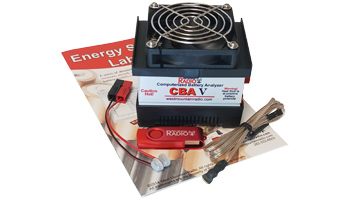
Energy Science Lab Kit
#S-203
$269.95
Click for Details
- CBA V Unit
- 12" Pigtail Adapter
- 6 ft USB Cable (A-B)
- 25 Amp Fuse
- Temperature Probe
- Universal Battery Holder (AA, AAA, C, D cell)
- USB Flash Drive of Standard Software and Instructional Materials
- Extended Software
- Lab Experiments Manual


Today's renewable energy solutions rely on batteries. The Energy Science Lab Kit is an educational series of detailed electrical experiments to precisely measure, record, and compare performance of various battery models, capacities, and chemistries. Teachers are able to show students real-world battery performance investigations that are interesting and relevant to all students relying on portable electronic devices as part of their daily lives! Exercises show how to measure battery effectiveness and identify the limitations.
Electrical Concepts:
- Voltage
- Current
- Resistance
- Power
- Energy
- STEM Lab Kit (Electrical)
- Middle/High School Science, Physics, Electronics & Trades
- NGSS referenced
- Detailed Instructor's Guide and Student Hand-outs
NGSS References
|
High School:
|
Middle School:
|
Experiments and Lab Overview
Five Experiments prepared for Instructor, Student and Inquiry versions:
- Brand Name vs. No Name - Test AA off-the-shelf batteries to determine which is the best value.
- Typical - I'm Not Typical - Explore how different discharge profiles affect Ampere-Hours capacity.
- Older, But Not Better - Determine the affects of aging on batteries.
- Size Really Matters - The real energy difference between AAA, AA, C, & D cells.
- Burr - I'm Cold - The affects of temperature variance on batteries.
Instructor version includes all necessary tables, test results, observations and conclusions.
Student version has clear objectives and step-by-step instructions to perform each experiment.
Inquiry version consists of two-page limited (open-ended) directions for advanced students.
Instructor Tools
- Detailed explanations provide insight and overview of each experiment
- Hand-outs for students to record data tables and sample charts
- Actual experiment test logs, sample runs, graphical images and raw data files
- Observations, conclusions, graphical results in Excel format
- Troubleshooting suggestions
- Safety warnings and considerations
- Internet references
Instructor's Edition
| Table of Contents | |
|---|---|
| Overview | 1 |
| Purpose of This Experiment | 3 |
| Curriculum Level/Grade Segment | 4 |
| Next Generation Science Standards | 5 |
| Material Required (Bill of Materials) | 6 |
| Pre-Experiment Recorded Data | 6 |
| Expected Outcome | 7 |
| Experimental Steps | 7 |
| Post-Experiment Measured Data | 9 |
| Observations and Conclusions | 10 |
| Experiment Summary | 11 |
| Possible Variations of Experiment | 13 |
| Troubleshooting/Safety Warnings | 16 |
| Appendix | |
| Blank Graph for Measured Results | 17 |
| Blank Pre-Experiment Recorded Data Table | 17 |
| Blank Post-Experiment Measured Data Table | 18 |
| Export Raw Data (Excel format) | 18 |
| Equipment Photos | 19 |
| Internet Resources/Battery Technical Links | 20 |
Specifications
CBA V Specifications
| Maximum continuous discharge (at ambient 75°F) | 1.5V: 60W 3V: 80W 6V: 120W 9V & up: 150W |
|||||||||||||||||||||
| Short term maximum discharge | 200W Example: 12V / 200W 1 minute max |
|||||||||||||||||||||
| Discharge current range | 0.01A to 40A | |||||||||||||||||||||
| Current Accuracy |
|
|||||||||||||||||||||
| Current Rise/Fall Time | <300 ms | |||||||||||||||||||||
| Voltage Accuracy | At CBA V connector: +/-1% Remote sense cable: +/-1% |
|||||||||||||||||||||
| Voltage range for battery under test | CBA V & CBA V Pro: 1V to 57V CBA V Pro 100: 1V to 100V |
|||||||||||||||||||||
| Sample rate | Standard software: 1 second Extended software: 50ms to 10 minutes |
|||||||||||||||||||||
| Residual current drain while battery is connected and not testing | Rough estimate: Current in ma = 0.27*Voltage - 0.25 For example 2.99ma at 12V |
|||||||||||||||||||||
| Maximum temperature for a full load | Ambient: 75°F Heat Sink: 140°F Internal: 205°F |
|||||||||||||||||||||
| PC | 32 or 64-bit Windows OS on Intel® or AMD processors (Virtual machines running Windows on these processors are OK) 4 GB memory minimum, 8 GB or more recommended USB port with full power (500ma) |
|||||||||||||||||||||
| Dimensions | 3.5" H x 2.8" W x 3.6" D | |||||||||||||||||||||
| Weight | 16 oz. | |||||||||||||||||||||
- High performance micro controller with built in USB interface and 12 bit A/D conversion.
- USB powered; the CBA does not use the battery being tested to run the CBA or the fan.
- System ready and Test in progress LED indicators, viewable from across a room.
- CBA internal over temperature sensing and protection.
- Graph printing on any standard color or B&W printer.
- Battery test label printing on Avery 5160 stick-on labels.
Includes
- CBA V Unit
- 12" Pigtail Adapter
- 6 ft USB Cable (A-B)
- 25 Amp Fuse
- Temperature Probe
- Universal Battery Holder (AA, AAA, C, D cell)
- USB Flash Drive of Standard Software and Instructional Materials
- Extended Software
- Lab Experiments Manual

